Banco Bradesco Bundle
What's the Story Behind Banco Bradesco?
Journey back in time to uncover the fascinating Banco Bradesco SWOT Analysis and its remarkable rise from a regional Brazilian bank to a global financial powerhouse. Established in 1943, this Bradesco company has consistently redefined the banking sector. Discover the key milestones that have shaped the Bradesco history.
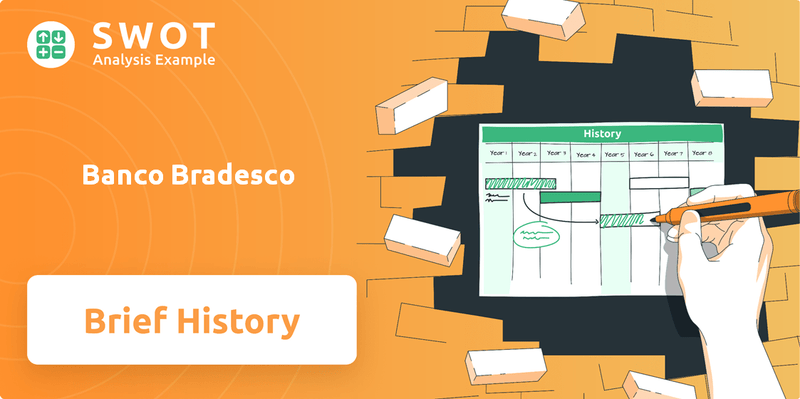
From its inception, Banco Bradesco, a leading financial institution in Brazil, focused on inclusivity, serving a diverse clientele often overlooked by larger institutions. Its commitment to accessibility and innovation fueled its expansion, transforming it into one of Latin America's largest banking institutions. This Brazilian bank's journey is a compelling case study in strategic growth and adaptation within the competitive financial landscape.
What is the Banco Bradesco Founding Story?
The story of Banco Bradesco, a significant player in the Brazilian banking sector, began on March 10, 1943. It was founded by Amador Aguiar in Marília, a city located in the interior of São Paulo state, Brazil. This marked the beginning of what would become one of the largest financial institutions in Latin America.
Aguiar's vision for the bank, initially named Banco Brasileiro de Descontos S.A., was rooted in financial inclusion. He aimed to create a democratic financial institution that would serve a wider segment of the population. This included individuals and market segments often overlooked by the established banks of the time.
The bank's initial funding model focused on attracting deposits from the local community it aimed to serve. This grassroots approach highlighted its commitment to community banking. The strategic choice of Marília as its founding location was a deliberate move. It was intended to cater to individuals outside the major urban financial centers, emphasizing its mission of financial inclusion. The bank's early business model centered on commercial banking, offering services like loans and deposit collection.
Bradesco history is marked by a clear vision and a focus on serving a broader audience. The bank's founder, Amador Aguiar, aimed to create a financial institution accessible to all.
- Founded in Marília, São Paulo, in 1943.
- Focused on serving farmers, small business owners, and government employees.
- Emphasized community banking with a grassroots approach to attracting deposits.
- The initial business model revolved around commercial banking services.
The bank's early success was built on its ability to connect with and serve the local community. This approach allowed it to grow steadily, expanding its reach and influence over time. For more insights into the strategies that have propelled Banco Bradesco, consider exploring the Growth Strategy of Banco Bradesco.
The bank's commitment to serving a diverse clientele, including those previously excluded from traditional banking services, set it apart. This strategy helped Bradesco company to establish a strong foundation for future growth and expansion within the Brazilian bank sector.
Banco Bradesco SWOT Analysis
- Complete SWOT Breakdown
- Fully Customizable
- Editable in Excel & Word
- Professional Formatting
- Investor-Ready Format
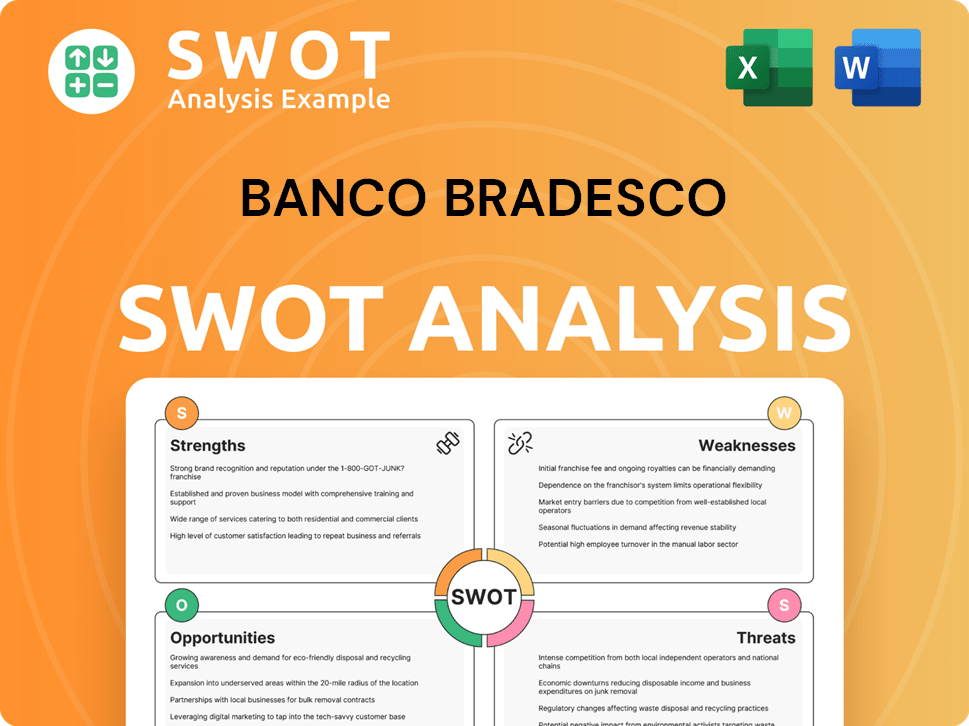
What Drove the Early Growth of Banco Bradesco?
The early years of Banco Bradesco, following its establishment in 1943, were marked by significant growth and expansion. This Brazilian bank quickly established itself as a key player in the banking sector. The company's strategic moves and technological adoption solidified its position as a leading financial institution in Brazil.
A pivotal step in Bradesco history was the relocation of its headquarters to São Paulo in 1946, and then to Cidade de Deus, Osasco, São Paulo, in 1953. This move reflected the company's growing operations and commitment to serving a wider customer base. The bank's expansion was further accelerated through strategic acquisitions.
During the 1970s, Banco Bradesco acquired 17 banks, significantly increasing its presence across Brazil. This strategy allowed the bank to broaden its reach in both urban and rural markets. This expansion was supported by the implementation of technological advancements.
In 1962, Bradesco company became the first Latin American company to acquire a computer, demonstrating its early commitment to innovation. This foresight continued with the launch of Brazil's first credit card in 1968. These technological advancements played a crucial role in the bank's growth.
By 2024, Banco Bradesco operated with 4,451 branches and 46,550 banking points across Brazil, serving a customer base of 75.4 million. The company's total assets for the quarter ending March 31, 2025, were $350.729 billion. For more insights, explore the Marketing Strategy of Banco Bradesco.
Banco Bradesco PESTLE Analysis
- Covers All 6 PESTLE Categories
- No Research Needed – Save Hours of Work
- Built by Experts, Trusted by Consultants
- Instant Download, Ready to Use
- 100% Editable, Fully Customizable
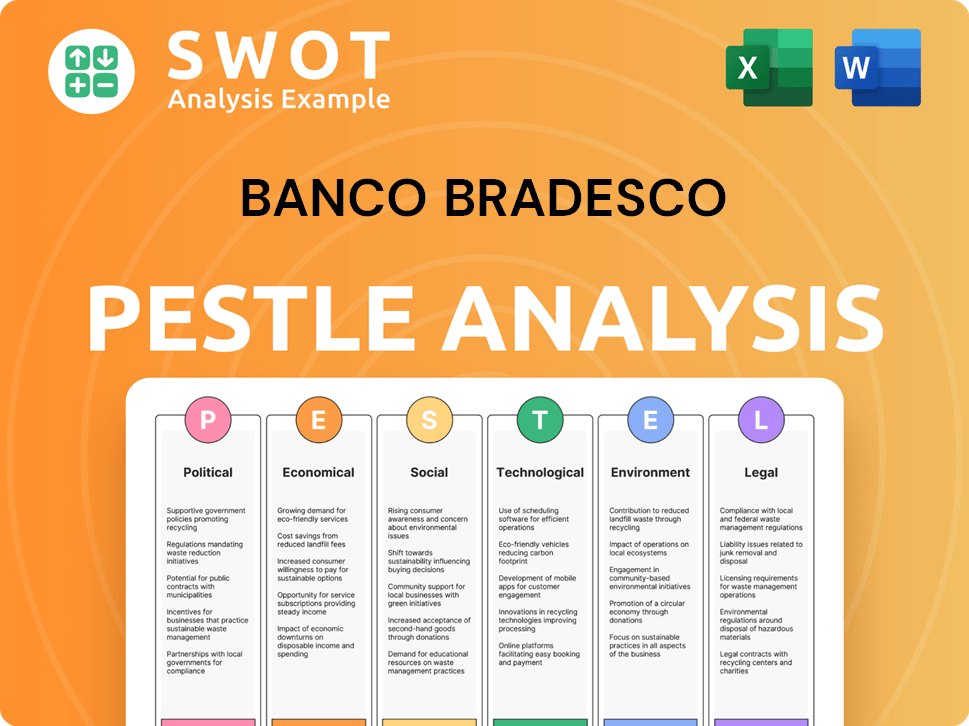
What are the key Milestones in Banco Bradesco history?
The Bradesco history is marked by significant milestones. The bank's journey includes pioneering financial services and adapting to the evolving needs of the Brazilian market.
| Year | Milestone |
|---|---|
| 1968 | Launched the first credit card in Brazil, a pioneering move in the financial institution Brazil. |
| 1996 | Introduced the first Latin American Internet Banking system, showcasing early adoption of technology. |
| 2024 | Committed R$3.2 billion to technology infrastructure, highlighting ongoing investment in technological advancements. |
Banco Bradesco has consistently embraced innovation to enhance its services. It has focused on technological advancements, including the application of artificial intelligence in banking.
Ongoing investments in technology, including AI, have been a key focus for the Brazilian bank. These advancements aim to improve efficiency and customer service within the banking sector.
Bradesco was the first in Latin America to offer Internet Banking, which significantly changed how customers interacted with their finances. This early adoption set a precedent for digital banking in the region.
Strategic investments in fintech have enabled Bradesco to provide innovative financial services. This approach has allowed the bank to stay competitive and meet evolving customer demands.
With increasing reliance on digital platforms, Bradesco has prioritized cybersecurity to protect customer data. This commitment ensures the security and trust of its clients.
Despite its successes, Banco Bradesco has faced challenges, including market downturns and competitive pressures. The company experienced rising credit costs in 2023, impacting its financial performance.
The Brazilian banking sector, including Bradesco, has faced economic challenges. The company has had to navigate periods of weak performance and rising credit costs.
The Brazilian banking sector is highly concentrated, increasing competition. The central bank aims to increase competition, adding further pressure on Bradesco.
In June 2023, the more-than 90-day nonperforming loan ratio peaked at 5.7%. This rise in nonperforming loans reflected broader economic challenges.
Bradesco is accelerating its transformation through a strategic plan to simplify operations and enhance management. This plan aims to improve profitability and competitiveness.
Improving economic conditions in Brazil are supporting Bradesco's recovery. Unemployment fell to 6.5% in January 2025, which is a positive indicator.
The 90-day nonperforming rate fell to 4.2% of total loans as of September 2024. This improvement is due to tighter underwriting standards.
Banco Bradesco Business Model Canvas
- Complete 9-Block Business Model Canvas
- Effortlessly Communicate Your Business Strategy
- Investor-Ready BMC Format
- 100% Editable and Customizable
- Clear and Structured Layout
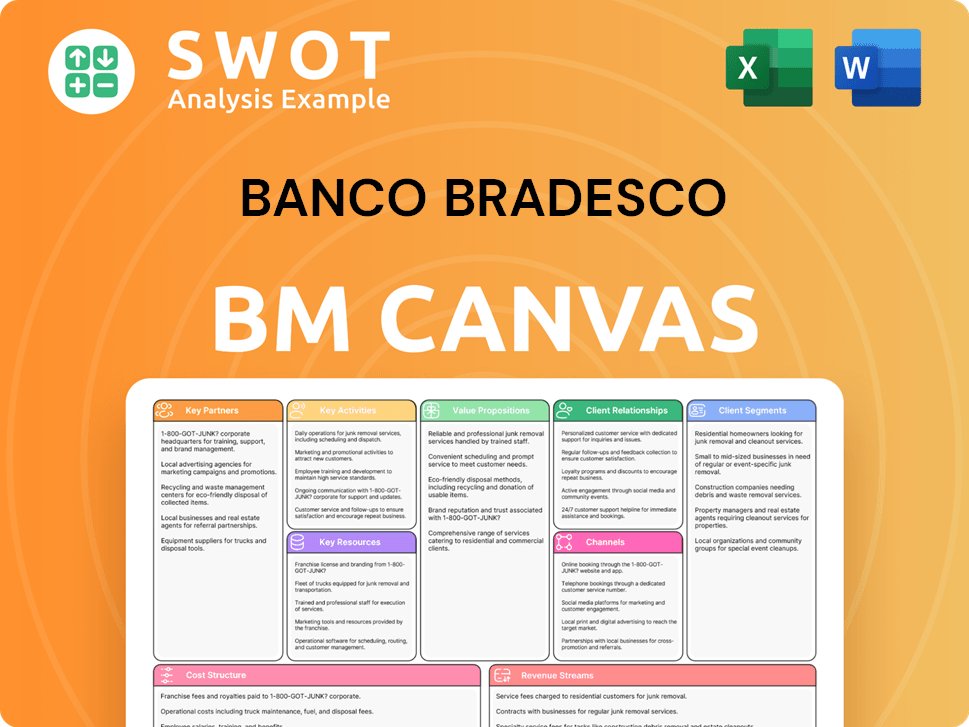
What is the Timeline of Key Events for Banco Bradesco?
The Bradesco history is marked by significant milestones, from its founding as Banco Brasileiro de Descontos S.A. in 1943 to its current position as a leading financial institution in Brazil. The Brazilian bank rapidly expanded, becoming the largest private bank in Brazil by 1951. Key developments include the establishment of Fundação Bradesco in 1956, the launch of Brazil's first credit card in 1968, and the introduction of the first Latin American Internet Banking system in 1996. The bank's growth strategy included acquisitions and international expansion, solidifying its presence in the banking sector.
| Year | Key Event |
|---|---|
| March 10, 1943 | Banco Brasileiro de Descontos S.A. was founded in Marília, São Paulo. |
| 1946 | Headquarters moved to São Paulo. |
| 1951 | Became the largest private bank in Brazil. |
| 1953 | Headquarters moved to Cidade de Deus, Osasco, São Paulo. |
| 1956 | Amador Aguiar creates Fundação Bradesco. |
| 1962 | First Latin American company to purchase a computer. |
| 1968 | Launched Brazil's first credit card. |
| 1970s | Acquired 17 banks across Brazil. |
| 1996 | Launched the first Latin American Internet Banking system. |
| 2000 | Commenced operations in Buenos Aires and New York. |
| 2010 | Acquired Ibi Mexican. |
| 2023 | Reported net income of R$28.9 billion. |
| 2024 | Recurring net income of R$19.6 billion, total assets reached approximately R$1.95 trillion. |
| January 2025 | Tier 1 capital increased to 12.8%. |
| Q1 2025 | Reported adjusted earnings per share (EPS) of 10 cents. |
Banco Bradesco anticipates a 4% to 8% increase in its expanded loan portfolio and fee and commission income for 2025. Operating expenses are projected to rise by 5% to 9%. Analysts forecast revenue to increase by 24.2% from 2023 to 2026.
The bank's strategic plan focuses on simplifying operations, enhancing management, and accelerating decision-making. It aims for 87% of customer interactions through digital channels and plans to expand artificial intelligence applications. This strategy is expected to yield significant benefits from 2025 onwards.
Bradesco is heavily investing in digital transformation and strategic partnerships. It has committed to R$500 billion in sustainable financing by 2025 and carbon neutrality by 2030. This aligns the bank with broader sustainability trends.
As of September 2024, Bradesco had a Tier 1 capital ratio of 12.7% and nonperforming loan coverage of around 169%. The bank's strong financial position provides a solid foundation for its future endeavors, supporting its growth and expansion in the banking sector.
Banco Bradesco Porter's Five Forces Analysis
- Covers All 5 Competitive Forces in Detail
- Structured for Consultants, Students, and Founders
- 100% Editable in Microsoft Word & Excel
- Instant Digital Download – Use Immediately
- Compatible with Mac & PC – Fully Unlocked
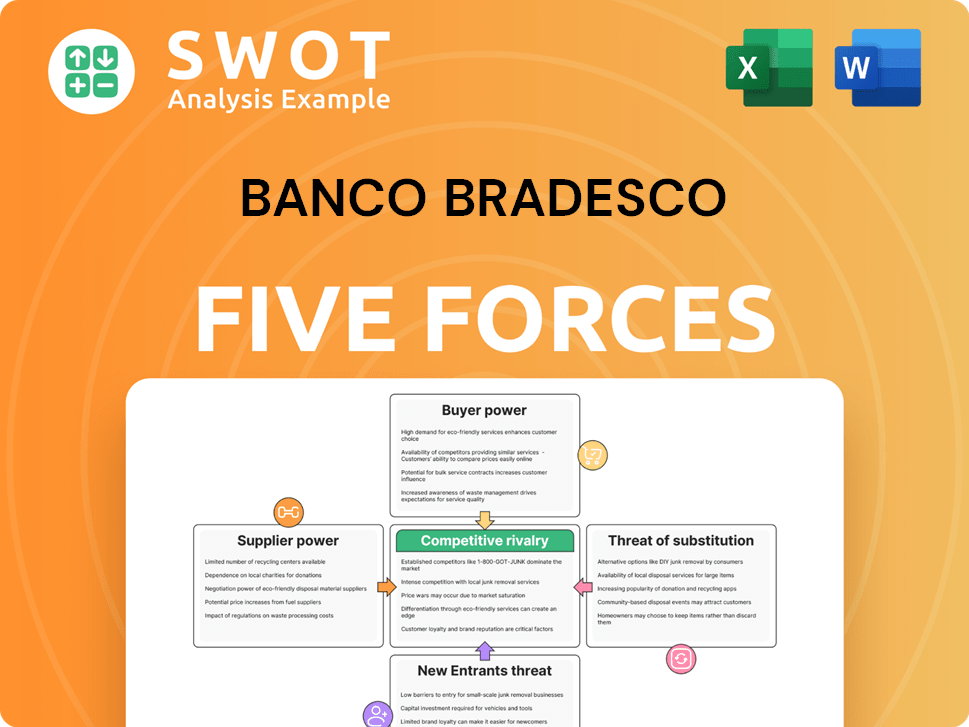
Related Blogs
- What is Competitive Landscape of Banco Bradesco Company?
- What is Growth Strategy and Future Prospects of Banco Bradesco Company?
- How Does Banco Bradesco Company Work?
- What is Sales and Marketing Strategy of Banco Bradesco Company?
- What is Brief History of Banco Bradesco Company?
- Who Owns Banco Bradesco Company?
- What is Customer Demographics and Target Market of Banco Bradesco Company?
Disclaimer
All information, articles, and product details provided on this website are for general informational and educational purposes only. We do not claim any ownership over, nor do we intend to infringe upon, any trademarks, copyrights, logos, brand names, or other intellectual property mentioned or depicted on this site. Such intellectual property remains the property of its respective owners, and any references here are made solely for identification or informational purposes, without implying any affiliation, endorsement, or partnership.
We make no representations or warranties, express or implied, regarding the accuracy, completeness, or suitability of any content or products presented. Nothing on this website should be construed as legal, tax, investment, financial, medical, or other professional advice. In addition, no part of this site—including articles or product references—constitutes a solicitation, recommendation, endorsement, advertisement, or offer to buy or sell any securities, franchises, or other financial instruments, particularly in jurisdictions where such activity would be unlawful.
All content is of a general nature and may not address the specific circumstances of any individual or entity. It is not a substitute for professional advice or services. Any actions you take based on the information provided here are strictly at your own risk. You accept full responsibility for any decisions or outcomes arising from your use of this website and agree to release us from any liability in connection with your use of, or reliance upon, the content or products found herein.